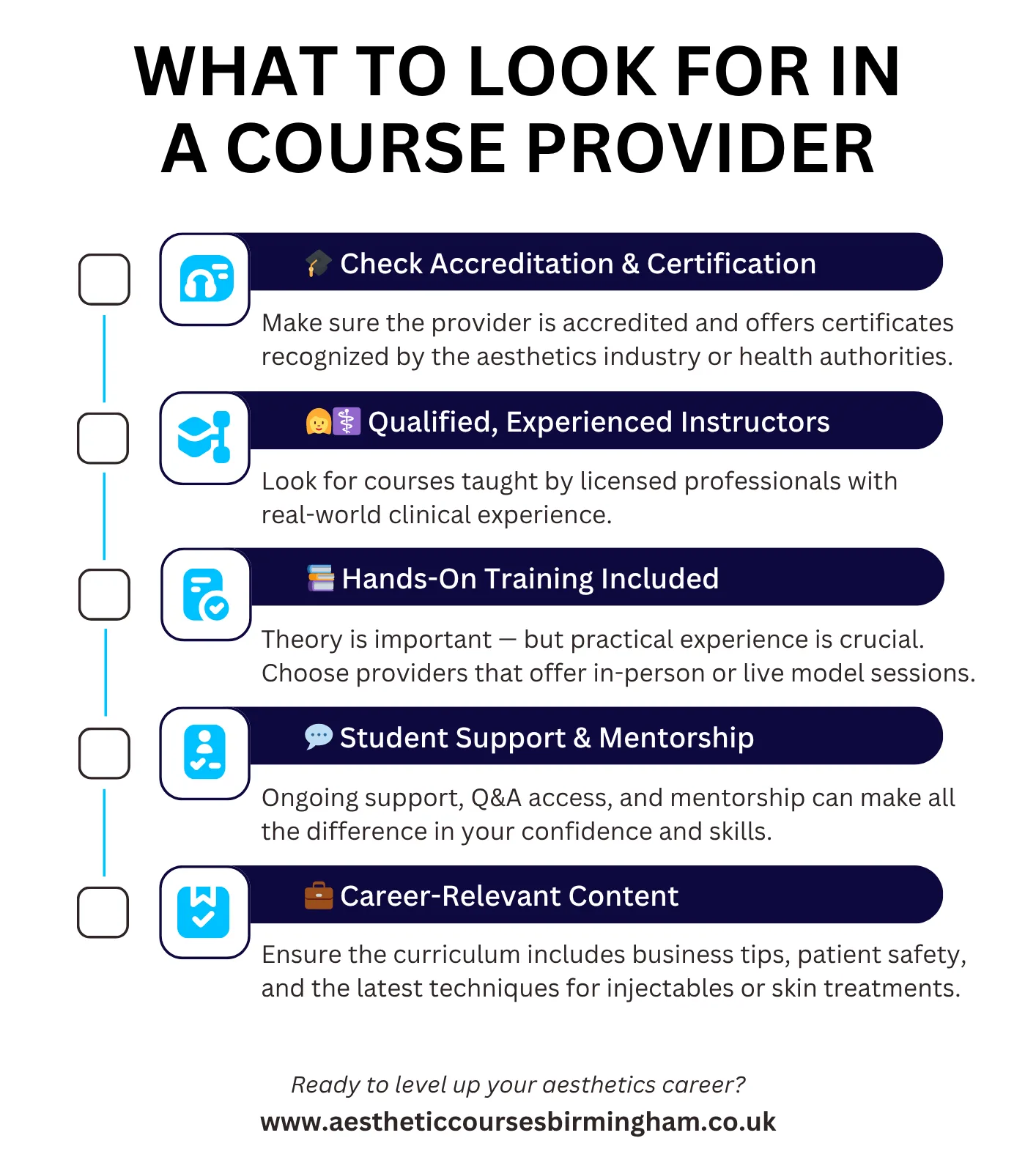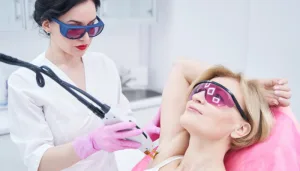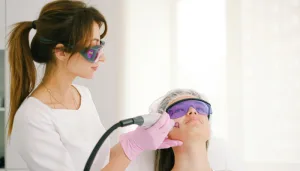
Aesthetic treatments are a growing field, and there are loads of opportunities out there. But, and this is a big “but”, you really need to pick the right training. Not all courses are created equal, and getting proper accreditation is a must. It’s all about making sure you’re learning the right stuff and that your qualifications will actually mean something.
This guide will help you figure out how to find accredited aesthetic courses, so you can start your career on the right foot.
Key Takeaways
- Always check for official accreditation from recognised bodies.
- Look into what specific qualifications like QUALIFI Levels 4, 5, and 7 mean for your career.
- Make sure the course covers everything you need to know, not just the fun bits.
- Research the people teaching the course; they should know their stuff.
- Think about what you want to do long-term and pick a course that fits your goals.
Understanding Accreditation in Aesthetic Training
Aesthetics is a growing field with lots of opportunities. But before you jump in, it’s really important to understand what accreditation means. It’s not just some fancy word schools throw around; it’s a sign that a course meets certain standards and that your qualification will actually be worth something in the real world. Let’s break it down.
Why Accreditation Matters for Your Career
Think of accreditation as a quality stamp. It tells employers (and clients) that you’ve received proper training and that you’re competent to perform aesthetic procedures.
Without it, you might find it hard to get a job or even insurance. Plus, some advanced courses might require you to have completed an accredited course beforehand. It’s about building a solid foundation for your future.
Recognising Reputable Awarding Bodies
So who decides what’s accredited and what isn’t? Well, there are several awarding bodies out there, and it’s important to know who the reputable ones are. Look out for names like QUALIFI and CIBTAC. These organisations set the standards for aesthetic training, and their qualifications are recognised both in the UK and internationally.
Doing your research here can save you a lot of hassle later on.
The Importance of Regulated Qualifications
Regulated qualifications are those that are officially recognised by a government body, like Ofqual in England. This means the course content, the trainers, and the assessment methods have all been checked and approved.
Choosing a regulated qualification gives you extra peace of mind that you’re getting a high-quality education. It also makes it easier to get insurance and to demonstrate your competence to potential employers. It’s a bit like having a safety net – you know you’re covered if anything goes wrong.
Basically, accreditation and regulation are your friends in the aesthetics world. They help you make smart choices about your training and set you up for a successful career. Don’t skip this step!
Identifying Key Accreditation Standards
Before you jump in, let’s talk about what makes a course actually good. It’s not just about fancy marketing; it’s about accreditation. Here’s how to spot the real deal.
Navigating Ofqual and Other Regulatory Bodies
Ofqual regulate qualifications in England, and if a course mentions them, that’s a good start. But don’t stop there! Make sure the specific qualification they’re offering is actually regulated by Ofqual.
Other regulatory bodies exist too, depending on the type of course. Do a little digging to see who should be regulating the course and check if they are.
Checking for Industry-Specific Approvals
Think of it like this: a general medical qualification is great, but it doesn’t mean someone’s an expert in, say, dermatology. The same goes for aesthetics. Look for approvals from industry-specific bodies.
These groups know what skills are needed right now and will only put their name to courses that meet those standards. It adds another layer of confidence.
Ensuring Comprehensive Curriculum Coverage
What’s actually in the course? This is huge. A good course won’t just teach you how to inject filler; it’ll cover anatomy, physiology, complications, and legal stuff.
Here’s a quick checklist:
- Anatomy and physiology
- Product knowledge (different types of fillers, toxins, etc.)
- Injection techniques (with hands-on practise)
- Complication management
- Legal and ethical considerations
A course might look shiny on the outside, but if it skips on the important stuff, it’s not worth your time or money. Make sure the curriculum is detailed and covers all the bases. It’s better to be over-prepared than under-trained, especially when people’s faces are involved!
Researching Potential Training Providers

Choosing the right training provider is a big step. You want to make sure they’re legit and can actually give you the skills you need. It’s not just about the piece of paper at the end; it’s about what you learn along the way.
Evaluating Course Content and Practical Experience
Look closely at what the course actually covers. Does it go into enough detail? Does it include hands-on practise? A course might sound good on paper, but if it’s all theory and no practical work, you might struggle when you start working with real clients.
Practical experience is key. Make sure the course offers plenty of opportunities to practise what you learn, ideally with real models under supervision.
Assessing Trainer Qualifications and Expertise
Who’s teaching the course? What are their qualifications? How much experience do they have in the aesthetics industry? You want trainers who know their stuff and can share real-world insights.
It’s worth checking their backgrounds and seeing if they’re still actively working in the field. A good trainer can make all the difference.
Reviewing Student Testimonials and Success Stories
What do past students say about the course? Were they happy with the training? Did they feel prepared to start their careers? Student testimonials can give you a good idea of what to expect.
Look for reviews that are specific and detailed, rather than just generic praise. Also, see if the training provider has any success stories they can share. It’s always encouraging to see how others have benefited from the course.
Choosing the right training provider is a big decision. Take your time, do your research, and don’t be afraid to ask questions. The more information you have, the better equipped you’ll be to make the right choice for your future.
Exploring Different Levels of Aesthetic Qualifications
Where do you start? Well, one of the first things you’ll notice is that there are different levels of qualifications. Let’s break down some common ones to give you a clearer picture.
QUALIFI Level 4 Aesthetic Practise
Level 4 is often seen as a good entry point. It gives you a solid foundation in the basics. You’ll likely cover things like:
- Basic skin anatomy and physiology
- Health and safety protocols
- Client consultation skills
- Introduction to common aesthetic procedures
It’s a good starting point if you’re new to the field and want to get your foot in the door. It’s like learning the alphabet before writing a novel, you know?
QUALIFI Level 5 Aesthetic Practise
Moving up to Level 5, things get a bit more advanced. You’ll start to delve deeper into specific treatments and techniques. Expect to cover:
- Advanced skin analysis
- More complex aesthetic procedures (like certain types of chemical peels or micro-needling)
- Managing complications
- Client care and aftercare
Level 5 is a step up, and it often requires you to have some prior experience or a Level 4 qualification. It’s about building on that foundation and becoming more specialised. Think of it as moving from basic cooking to mastering a specific cuisine.
QUALIFI Level 7 Aesthetic Practise
Level 7 is where you really start to specialise and gain a high level of expertise. This level is often aimed at medical professionals (like nurses or doctors) or experienced practitioners looking to expand their skills. You might cover:
- Advanced injection techniques (like Botox and dermal fillers)
- Complex skin conditions and treatments
- Business and management aspects of running an aesthetic clinic
- Research and development in aesthetics
Level 7 is a big commitment, but it can really set you apart in the industry. It’s about becoming a leader in your field and offering the most advanced treatments available.
Choosing the right level depends on your background, experience, and career goals. Don’t rush into it – do your research and pick the qualification that’s right for you.
Specialised Accredited Aesthetic Courses
There are courses out there that really focus on particular areas within aesthetics. Let’s have a look at some examples.
QUALIFI Level 4 Diploma Aesthetic Procedure For Beginners
QUALIFI Level 4 Diploma Aesthetic Procedure For Beginners diploma is perfect if you’re just starting out. It gives you a solid base in the most common aesthetic procedures. You’ll learn the basics, like how to consult with clients, understand skin types, and perform treatments safely.
It’s a great way to build your confidence and get your foot in the door.
QUALIFI Level 4 Certificate in Anatomy and Physiology for Aesthetic Practise
Okay, so this one might sound a bit dry, but trust me, it’s super important. You need to know your stuff when it comes to Level 4 certificate in anatomy and physiology. This certificate will give you a good understanding of how the body works, which is vital for performing any aesthetic procedure safely and effectively. It covers things like:
- The structure of the skin
- Muscles of the face and neck
- The nervous system
CIBTAC Level 4 Certificate in Laser and Light Treatments
Laser treatments are really popular, so getting certified in this area can be a smart move. This CIBTAC Level 4 Certificate will teach you how to use laser and light-based technologies for things like hair removal, skin rejuvenation, and treating pigmentation.
You’ll learn about laser safety, different types of lasers, and how to choose the right treatment for each client.
Getting a specialised qualification can really set you apart from the crowd. It shows that you’re serious about your career and that you’re willing to put in the work to become a true professional.
Verifying Course Legitimacy and Recognition
So, you’ve found a course that looks amazing, ticking all the boxes. But before you hand over your hard-earned cash, it’s really important to make sure it’s the real deal. Let’s look at how to check if a course is actually legit and recognised.
Cross-Referencing with Official Registers
One of the best ways to check a course’s legitimacy is by cross-referencing it with official registers. Awarding bodies like Ofqual (in England) or similar organisations in other regions maintain registers of recognised qualifications and training providers. It’s a bit like checking if a company is registered at Companies House.
If the course or provider isn’t listed, that’s a big red flag. It might mean the course isn’t properly accredited, or worse, it could be a complete scam.
Contacting Awarding Bodies Directly
Sometimes, websites can be out of date, or information might be presented in a way that’s a bit misleading. If you’re unsure about something, don’t hesitate to contact the awarding body directly. Give them a ring or send them an email, and ask them to confirm whether the course is accredited by them and if the training provider is recognised.
It might seem like a bit of a hassle, but it’s worth it for the peace of mind. Plus, it shows the awarding body that people are taking accreditation seriously, which is always a good thing.
Understanding Professional Indemnity Insurance Requirements
Professional indemnity insurance is super important in the aesthetics industry. It protects you if something goes wrong and a client makes a claim against you. But here’s the thing: many insurance companies will only provide cover if you’ve completed a recognised and accredited course.
So, before you enrol on a course, check with insurance providers to see if they recognise the accreditation. If they don’t, you might struggle to get insurance later on, which could seriously limit your career options.
It’s always better to be safe than sorry. Taking a few extra steps to verify a course’s legitimacy and recognition can save you a lot of time, money, and stress in the long run. Plus, it’ll give you the confidence to know that you’re getting a quality education that will set you up for success in the aesthetics industry.
Here’s a quick checklist to keep in mind:
- Check official registers for the course and provider.
- Contact the awarding body to confirm accreditation.
- Verify that insurance companies recognise the accreditation.
Making an Informed Decision for Your Future
Okay, so you’ve done your research, looked at different courses, and hopefully, you’re feeling a bit more clued up about accredited aesthetic training. But how do you actually choose the right course for you? It’s a big decision, and it’s worth taking the time to get it right.
Considering Your Career Aspirations
First things first, what do you actually want to do? Think about the specific aesthetic procedures you’re interested in offering. Are you dreaming of becoming a master of injectables, or are you more drawn to laser treatments?
Maybe you want to specialise in skincare. Your career goals should really drive your course selection. Don’t just pick a course because it’s popular; pick it because it aligns with where you want to be in a few years.
Budgeting for Quality Accredited Training
Let’s be real, accredited training isn’t cheap. But it’s an investment in your future. It’s better to save up for a good course than to cut corners and end up with a qualification that isn’t worth the paper it’s printed on.
Here’s a few things to consider:
- Course fees (obviously)
- Travel expenses (if the course isn’t local)
- Equipment costs (some courses require you to buy your own kit)
- Insurance (you’ll need this to practise)
- Potential loss of earnings (if you’re taking time off work to study)
Planning for Continuous Professional Development
Once you’ve got your initial qualification, that’s not the end of the road. The aesthetics industry is constantly evolving, with new techniques and technologies emerging all the time. You’ll need to commit to continuous professional development (CPD) to stay up-to-date and maintain your skills. This could involve attending workshops, conferences, or taking further courses. Think of it as a lifelong learning journey.
Investing in CPD isn’t just about keeping your skills sharp; it’s also about demonstrating to your clients that you’re committed to providing the best possible care. It builds trust and credibility, which is essential for success in this industry.
Conclusion
Picking the right aesthetic course is a big deal, and it helps to know what to look for. Always go for places that are properly accredited; it just means you’re getting good, recognised training. Think about what you want to learn, check out what past students say, and make sure the course fits your goals.
Doing your homework now will save you a lot of bother later on. You’re setting yourself up for a good career in aesthetics, and that starts with a solid education.
Frequently Asked Questions
What does 'accredited' mean for an aesthetic course?
Accreditation means a course has been checked and approved by a proper group. This makes sure the training is good quality and meets industry rules. It shows future employers you have learned what you need to know from a trusted source.
How can I tell if an awarding body is trustworthy?
Look for groups like Ofqual, which is a government body that checks education standards. Also, see if the course is approved by specific beauty or aesthetic organisations. A good sign is when the course is linked to well-known awarding bodies.
Are regulated qualifications really necessary?
Yes, it is very important. These qualifications mean the course follows strict rules and standards. This helps you get insurance and shows you are serious about your job, which is key for working safely and legally in the aesthetic field.
What should I check when researching training providers?
You should look at what topics the course covers and if it includes hands-on practise. Check the teachers’ backgrounds and how much experience they have. Also, read what past students say about the course and their success after finishing it.
What's the difference between QUALIFI Level 4, 5, and 7 Aesthetic Practise?
These levels show how advanced a course is. Level 4 is usually for beginners, Level 5 is more advanced, and Level 7 is for highly skilled practitioners, often for more complex treatments. Each level builds on the last, giving you more knowledge and skills.
How do I know if a course is truly legitimate?
Always double-check with the official groups that give out the awards. You can also contact the awarding bodies directly to make sure the course is truly recognised. Understanding what insurance you’ll need is also a good step to ensure you’re fully covered for your future work.






